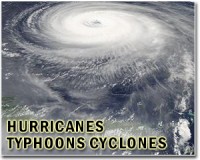| . |  |
. |
Tully, Australia (AFP) Feb 3, 2011 As Cyclone Yasi's roaring winds and lashing rains closed in, Red Cross worker Noelene Byrne made a fortuitous last-minute decision to abandon her makeshift evacuation centre. The next thing she knew the building in Tully was "one mangled heap", Byrne told ABC radio. "Had I left people there, there would have been loss of life," she said. "The destruction there is just heartbreaking. It's just the front wall of the hall that's standing, the rest is just one big scrap heap. "It's just like weapons have come through, bombs have come through and destroyed everything." Cairns, a popular tourist hub on the northeast coast, escaped the worst of Yasi, a category five storm that lashed the area with gusts of up to 300 kilometres (185 miles) an hour. But other towns were not so lucky. Queensland Premier Anna Bligh said emergency workers would have to "cut their way in" to get a real sense of the destruction in Tully, with preliminary estimates suggesting 90 percent of the main street was wrecked. The town's hospital had its roof sheared away and one in three homes had suffered some sort of damage, Bligh said. Dazed livestock roamed flooded streets and banana plantations lay flattened, while homes were without roofs, windows, and even walls. Some houses were lifted from their foundations or split in two by the savage squalls, and huge trees lay across roads and power lines, torn whole from the ground with their knotted roots whipping in the wind. "The flat from across the street is in our front yard and we can see other houses which have just been destroyed," said Tully resident Stephanie Grimaz, whose concrete home shook with the blasting winds' jet-engine roar. "There are sheets of iron everywhere, the streets are just full of debris." In Cardwell, aerial pictures showed house after house with its roof shorn off, a shattered church had its roof blown away, and the town was covered in mud left behind by the surging ocean waters Yasi whipped up. At nearby Port Hinchinbrook, dozens of luxury yachts swept from their berths were piled on top of each other like discarded toys, while the marina lay empty. Exhausted residents who cowered in basements and bathrooms through a terrifying night of shrieking winds emerged to inspect the damage, stunned at the scenes before them. "There's so much damage it's just incredible," Tully cane farmer Vince Silvestro told AAP news agency. "Our crops are completely destroyed... The countryside is completely stripped, the trees, even the hospital's damaged. "When I woke up it looked like what it would have looked like in World World II or something if the city had been bombed." But with many expecting significant loss of life from what was described as Australia's "storm of the century", most were counting their blessings as they swapped tales of lucky escapes and scary close shaves. Mechanic Scott Torrens, 37, described how he was sitting at his kitchen table when the roof was ripped from the building, forcing him to hide his three children under mattresses during the long, frightening night. "We were sitting at the kitchen table, we heard a ripping and off came the roof. Before we knew about it, it was gone. It happened that quick," Torrens told AFP. One 71-year-old grandmother, whose surname was given as French, described her terror as the walls of her bathroom began to collapse and gusting winds blew a sheet of iron into the kitchen windows, sending shards of glass flying through the house. "It sounded like a freight train coming through my house," she said. "I'm not someone who gets scared easily, but I was just petrified.
Share This Article With Planet Earth
Related Links Bringing Order To A World Of Disasters When the Earth Quakes A world of storm and tempest
 Terrified Australians await cyclone fury
Terrified Australians await cyclone furyInnisfail, Australia (AFP) Feb 2, 2011 Anxious families hunkered silently on the floor of a makeshift shelter, pets and a few precious belongings around them, waiting for dreaded Cyclone Yasi to unleash its terrible fury. More than 10,000 people from around the small banana and sugarcane farming town of Innisfail were evacuated from their homes as the category five storm barreled directly towards them with awe-inspiring ferocity. ... read more |
|
| The content herein, unless otherwise known to be public domain, are Copyright 1995-2010 - SpaceDaily. AFP and UPI Wire Stories are copyright Agence France-Presse and United Press International. ESA Portal Reports are copyright European Space Agency. All NASA sourced material is public domain. Additional copyrights may apply in whole or part to other bona fide parties. Advertising does not imply endorsement,agreement or approval of any opinions, statements or information provided by SpaceDaily on any Web page published or hosted by SpaceDaily. Privacy Statement |